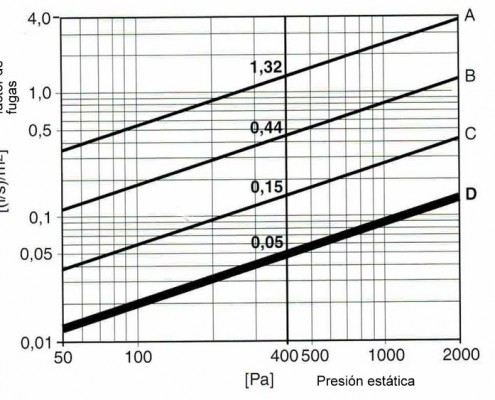Classification sealing ventilation ducts
Vent Circular versus rectangular
A duct system is never completely watertight. Usually leaks by the transverse and longitudinal joints. Air leakage increases with the pressure difference between the inside and outside of the duct.
Normally, a network of ventilation ducts is formed by elements of different typology: ducts circular, rectangular ducts, hoses, the Fibra etc..
The critical points rectangular ducts are both the metal Cross connector and as the logitudinal.
In the cross connection occurs in:
- fixing the frame to the duct
- the four corners
- the contact surface of the faces of the frame when the pipes are joined together
In the longitudinal joint, air can escape to a greater or lesser amount by the fold assembly used in the plate surfaces to form the piece with the precise geometry. And this depends on the system engrafado, and the heat used in the closure of same.
In the circular duct the main points of leakage are those occurring at joints due to the clearance between the straight line section and the workpiece when plugged, areas where abuses the welding for making the longitudinal union of accessories and standard folding propeller on the conduit itself is constructed.
Classes estanqueuidad A,B,C,and D
The current Spanish rule UNE-EN 12237 sorts the channels in 4 sealing levels, At the level of D ( low to high).
The graph shows air leaks in a system l / s per m2 depending on the static pressure in the installation. Ultimately, is expressed as the sealing classification ventilation ducts.
The graph shows that a vent of the clase D this is 3 times that of the sealed clase C, which in turn is 3 times that of the clase B and himself on.
The tightness of the duct is defined by the following equation:
f= c×p0,65
where:
f represents air leakage in dm³ / s · m²
p is the static pressure in Pa
c coficiente is the class that defines the sealing
Class c = 0,027
Class B c = 0.009
C Class c = 0.003
Class D c = 0.001
What kind of canal is tight? Consider the degree of tightness that offer regular vents. We considered that are well built and assembled workshop ducts properly with sealants and mastics manufacturers recommended.
- Circular conduit for union with plug sealed with putty on tape : Classification B
- I circular pipe plug connection with O-ring: Classification C
- Duct with rectangular frame preformed: Classification B-C
With very careful and elaborate constructions can achieve degrees of tightness circular duct type D and type C in rectangular duct.
Importantly as well built in a duct where attention to the smallest detail, with high expectations sealing, fustradas these can become careless and wrong with mounting. Thus, the manufacturer must inform and prepare the installer on knowledge of the characteristics and virtues of each duct system to conserve and enhance the properties thereof. Good conduct is the basis for running a good ventilation network. A precarious passage can not possibly provide a good seal to the system even with the good work of the editor.
How do we know that class watertightness have a facility? Measuring the level of sealing is effected by a facility specific field analyzers, on several representative samples of the entire network installed duct. Each sample will consist of straight and accessory parts with a minimum length of 2,5 m and an upper surface to 10m2. Furthermore the relationship between the total length of joints and pipe surface is greater than unity. The assay is carried out both positive and negative pressures , at least 5 measures each, within a pressure range up to the maximum static pressure. The duration of each step is at least 5 minutes.




